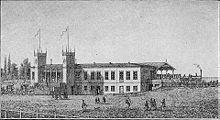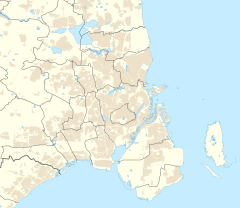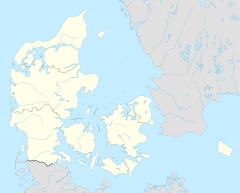Copenhagen Central Station
You can help expand this article with text translated from the corresponding article in Danish. (November 2023) Click [show] for important translation instructions.
|
| S-train, Metro and national railway station | |
 Building seen from Bernstorffsgade | |
| General information | |
| Location | Banegårdspladsen 7 DK-1570 Copenhagen V[1] |
| Coordinates | 55°40′22″N 12°33′52″E / 55.67278°N 12.56444°E |
| Elevation | 3 m (9.8 ft) above sea level |
| Owned by | DSB |
| Operated by | DSB |
| Platforms | 7 (island platforms including Metro, 1 long-distance) |
| Tracks | 15 (9 InterCity/Regional/International, 4 S-train, 2 Metro) |
| Bus routes | |
| Construction | |
| Platform levels | 2 |
| Architect | Heinrich Wenck[2] |
| Other information | |
| Station code | Kh |
| Fare zone | 1 |
| History | |
| Opened | 1 December 1911 |
| Rebuilt | 15 May 1934 (S-train) |
| Electrified | 1934 (S-train), 1986 (Mainline) |
 | |
| Location | |
Copenhagen Central Station (
Copenhagen Central Station is the hub of the
The first station in Copenhagen opened in 1847. The current station building opened in 1911 and is the work of architect Heinrich Wenck. The station has 7 platforms and 13 tracks. On the station concourse there are many small shops, restaurants, cafés, and fast food outlets.
Location

The central station is located in the centre of Copenhagen, on the south-eastern perimeter of the historic
The station is situated in a dense urban environment; To the east, it is immediately adjacent to the inner-city
The station building has entrances from Bernstorffsgade, Banegårdspladsen and Reventlowsgade, and the platforms have direct access via stairs from Tietgensbroen. The underground
History
First station

The first railway station in Copenhagen was constructed on behalf of
The station was located at the site of Dronningens Enghave (English: the Queen's Meadow Garden), a former royal pleasure garden located just outside the Vesterport (English: Western Gate) city gate of Copenhagen. The first station was located approximately at the site of the current station, but the tracks were perpendicular to their current direction, as the railway line then left the city along the current streets Halmtorvet and Sønder Boulevard. The station building was constructed of wood as it was built outside the city's fortifications within the demarcation line, a no-build zone outside the ramparts where brick buildings were not allowed for military reasons. In case of war, the army should be able to burn buildings in the firing range outside the ramparts.
This railway station and the still existing
The first station building was demolished in 1865.
Second station

In the 1860s, there were several plans to expand the
.
The new railway station was located a little north of the location of the old one, on the other side of

The station building was designed by the
In the long run, however, this second station also became too cramped, especially because it was a
The third and current railway station

By the end of the

The new station was opened on 30 November 1911 by Crown Prince Christian, who stated:
It will probably stand as a monumental reminder of Danish architecture in the beginning of the 20th century. As I express the wish that our new station may make establish a more firm connection between the capital and the country and between Denmark and abroad, I declare Copenhagen Station open!.[14]
The following day, 1 December, the first train departed from the station.[15]

Since the northbound tunnel (the
The station was overhauled in 1980. Escalators and lifts were established to the platforms, and the station concourse, which was originally split into arrival, departure, and freight sections, was redone completely. The station was overhauled again from 2004 to 2008. This overhaul replaced the roof, lowered platforms 3 to 6 to international standards and lengthened them. The towers and the bridge over the platforms, upon which the main station building is placed, were reconditioned.
Architecture

The station was designed by

The station is designed in National Romantic style, a Nordic architectural style that was part of the National Romantic movement during the late 19th and early 20th centuries, and which is often considered to be a form of Art Nouveau. The prominent materials are brick, slate and granite, and a host of decorative details have been added. Inspired by Herholdt's railway station, Wenck also used a wooden arch construction both in the two departure and arrival halls and in the 6 arches over the platforms. It was probably just as much a stylistic choice, since Wenck rarely used cast iron. However, the entire railway station's foundation, basement and the platform that support the railway station site are made of reinforced concrete.

Wenck's building is a gesamtkunstwerk, where the architect has drawn all the details; right from the Bornholm tiles, benches, the large chandeliers, of which 12 pieces originally hung (2 are set up in the hall, 2 others are found at Østerport Station), the kiosks, wrought iron signs with neat writing, door handles and brass signs with DSB logo and stained glass windows with city coats of arms from Danish cities.

The Danish
Layout



The station has 7 platforms and 13 tracks. The platforms begin under the main passenger hall (and at least the S-train section, two platforms with a total of four S-train tracks, of the station can be said to begin as an underground station). A hotel (Astoria) is built above the S-train tracks in the Northern end, but the remaining tracks are uncovered below street level. (Open areas between tunnel sections were necessary to have during the era of steam trains, while the S-trains always have been electrical). In the opposite (platform) end, all platforms are covered with the typical railway arched roof. This roof is shorter than the platforms, but all tracks remain below street level and can also be accessed from the street Tietgensgade.
In addition to the original 6 island-platforms and their 12 tracks,[18] has one additional track constructed much later. The single spare track, called track 26, was initially built for trains to southern Sweden, while Malmö C still was a terminus. It has later been used for express trains to or from
The station services the
Facilities

The main concourse also functions as a marketplace where fresh fruit sellers, newsstands, a post office, ATMs, currency exchanges, hamburgers, coffee shops, restaurants and pubs can all be found. There is also a travel center for information, a police station, and windows for the in-person sale of tickets, along with access to toilets. Shower rooms are also available for a smaller fee.
Services

Copenhagen Central Station provides Copenhagen with Intercity and Express trains across Denmark, as well as services to several international destinations.
Direct international trains connect to Stockholm and Hamburg several times a day.
Intercity trains run half-hourly from Copenhagen during daytime and serve as a link between the major cities and towns in Denmark, including Odense, Aarhus, Aalborg, Esbjerg, Thisted and Sønderborg.
Regional trains (stops at major stations within the Greater Copenhagen area) connect the main parts of Zealand to the capital. The Øresundståg regional rail network depart to southern and western Sweden every 20 minutes (24/7 service between Lund Central Station and Østerport Station).
All
From 29 September 2019 the Central station is also served by the Copenhagen Metro network's line M3 (in service 24/7), which is a circular line with 17 stations. The station is also served by the M4 line, linking the Nordhavn and Sydhavn districts and serve as an interchange between the Sydhavn extension and the M3.
Long-distance buses stop at Ingerslevsgade near track 12 just south of the Tietgensgade bridge.
All public transport within Greater Copenhagen are divided into close to 100 ticket fare zones. The Central station is located in fare zone 1, which together with zones 2 and 3 constitute Copenhagen municipality and the "enclave" of
| Preceding station | DSB | Following station | ||
|---|---|---|---|---|
| Copenhagen Airport Terminus
|
InterCityLyn
|
Odense
towards Aalborg Airport | ||
InterCityLyn
|
Odense
towards Struer | |||
InterCityLyn
|
Odense
towards Sønderborg | |||
| Terminus | Copenhagen-Aalborg | Copenhagen South towards Aalborg
| ||
Østerport
|
Copenhagen–Esbjerg | Esbjerg
| ||
| Terminus | Copenhagen–Odense–Hamburg | Ringsted towards Hamburg Hbf
| ||
Østerport
|
Regional train
|
Ørestad
towards Malmö C and beyond | ||
| Nørreport or Lufthavnen towards Copenhagen Airport
|
Regional train
|
Valby
towards Slagelse | ||
Nørreport
towards Helsingør |
Regional train
|
Copenhagen South towards Næstved
| ||
Regional train
|
Valby
towards Næstved | |||
Østerport
|
Nykøbing F
|
Nykøbing F
| ||
Regional train
|
Høje Taastrup towards Kalundborg
| |||
Regional train
|
Valby
towards Holbæk | |||
| Preceding station | SJ | Following station | ||
| Terminus | Southern Main Line | Copenhagen Airport towards Stockholm Central
| ||
| Preceding station | Following station | |||
Ballerup
|
H Mon–Fri
|
Østerport
| ||
Dybbølsbro
towards Frederikssund |
C | Klampenborg
| ||
Dybbølsbro
towards Høje Taastrup |
Bx Peak hours
|
Buddinge
| ||
| B | Farum
| |||
Dybbølsbro
towards Solrød Strand |
A | Vesterport
towards Hillerød | ||
Dybbølsbro
towards Køge |
E Mon–Fri
|
Vesterport
towards Holte | ||
| Preceding station | Following station | |||
| Enghave Plads clockwise
|
M3 | Rådhuspladsen counter-clockwise
| ||
| Terminus | M4 | Rådhuspladsen towards Orientkaj
| ||
Future
The station needs more capacity following the opening of the
Number of travellers
According to the Østtællingen in 2008:[19]
| År | Antal | År | Antal | År | Antal | År | Antal |
|---|---|---|---|---|---|---|---|
| 1957 | 15.984 | 1974 | 17.711 | 1991 | 22.771 | 2001 | 27.394 |
| 1960 | 14.359 | 1975 | 15.797 | 1992 | 23.167 | 2002 | 25.502 |
| 1962 | 15.604 | 1977 | 14.855 | 1993 | 22.825 | 2003 | 24.858 |
| 1964 | 14.892 | 1979 | 20.228 | 1995 | 24.371 | 2004 | 23.648 |
| 1966 | 16.390 | 1981 | 23.689 | 1996 | 25.739 | 2005 | 23.931 |
| 1968 | 17.176 | 1984 | 24.612 | 1997 | 25.801 | 2006 | 24.905 |
| 1970 | 17.904 | 1987 | 24.833 | 1998 | 25.977 | 2007 | 22.201 |
| 1972 | 18.060 | 1990 | 23.316 | 2000 | 29.150 | 2008 | 21.666 |
Cultural references
In film
Copenhagen Central Station is used as a location at 1:12:36 in the 1975
See also
- Transportation in Denmark
- Transportation in Copenhagen
- Rail transport in Denmark
- History of rail transport in Denmark
- List of railway stations in Denmark
- Danish State Railways
- Banedanmark
Notes
- German rail network.[6]
- ^ The Copenhagen Steam Railway Galop was included in the 2006 Danish Culture Canon as a masterpiece of Danish classical music.[9]
- Copenhagen East station (now: Østerport station) until 1917.[13]
References
Citations
- ^ a b c d "København H" (in Danish). DSB. Retrieved 3 May 2021.
- ^ Kunstindeks Danmark & Weilbachs Kunstnerleksikon. Retrieved 6 October 2022.
- ^ "24-årig mand falder gennem glastag på Hovedbanegården og dør". Politiken (in Danish). 7 July 2019.
- ^ "Frelsens hær bød på julegrød og julemusik på Hovedbanen" (in Danish). The Salvation Army. 3 December 2019.
- ^ "Travelling in Denmark". DSB. Retrieved 25 November 2013.
- ^ Jensen 1972, p. 11.
- ^ Jensen 1972, p. 12-16.
- ^ "Jernbanen KBH-Korsør" (in Danish). Kutlurstyrelsen. Archived from the original on 4 March 2016. Retrieved 16 December 2014.
- Kulturministeriet. Archived from the original(PDF) on 4 March 2016. Retrieved 18 March 2018.
- ^ "H. C. LUMBYE COMPOSITIONS sorted by year". erikoest.dk. Retrieved 22 March 2024.
- ISBN 87-21-00499-4.
- ISBN 978-87-7289-238-2.
- ^ a b c Flindt Larsen 1994, p. 4.
- ^ "Københavns Hovedbanegård fylder 100 år". dsb.dk. DSB. 21 November 2011.
- ^ Flindt Larsen 1994, p. 5–6.
- ^ Flindt Larsen 1994, p. 6–7.
- ^ Sten Hartung. "Jens Lund" (in Danish). Kunstindeks Danmark & Weilbach Kunstnerleksikon. Retrieved 25 October 2023.
- ^ "Københavns Hovedbanegård – Gyldendal – Den Store Danske". denstoredanske.dk. 11 June 2017.
- ^ "Østtælling 2008 DSB og DSB S-tog". 13 November 2008. p. 17. Archived from the original on 18 May 2023.
- ^ "Film 7 Olsen banden på sporet / Die Olsenbande stellt die Weichen". olsenbande-homepage.de (in German). Retrieved 5 October 2017.
- ^ "Film 9 Olsen Banden deruda / Die Olsenbande schlägt wieder zu". olsenbande-homepage.de (in German). Retrieved 5 October 2017.
Bibliography
- Flindt Larsen, Morten (1994). Vi mødes under Uret... Glimt af livet på Københavns Hovedbanegård gennem tiden [We meet under the Clock ... Glimpses of life at Copenhagen Central Station through time] (in Danish). ISBN 87-88632-51-2.
- Jensen, Niels (1972). Danske Jernbaner 1847–1972 [Danish railways 1847–1972] (in Danish). ISBN 87-11-01765-1.
- Moe, Steffen; Birch, Søren; Olsen, Cyril; Grontmij; Arkitekter, Public (2011). Historien om et succesfuldt renoveringsprojekt : Københavns Hovedbanegård projekt Kh 08 (in Danish). ISBN 9788798935049.
- Poulsen, John (1997). Byens Baner: Jernbanen i København gennem 150 år (in Danish). ISBN 87-88632-67-9.
- Poulsen, John (1986). Københavns banegårde: København H. 1. december 1911-1986 (in Danish). ISBN 87-88632-14-8.
- Poulsen, John; Christensen, Jens Ole; Thomassen, Peer; Zeeberg, Nils Kristian (1984). Københavns S-bane 1934-1984 (in Danish). ISBN 87-88632-01-6.
- Poulsen, John; Larsen, Morten Flindt (2009). S-banen 1934-2009 (in Danish). ISBN 978-87-91434-20-4.
- Raabyemagle, Hanne; Vitus Nielsen, Poul (1991). "Fredningsværdier i dansk jernbanearkitektur". Fabrik og Bolig (in Danish). 2.
- Vibæk, Jens (1989). "Debatten om Københavns 3. hovedbanegård 1864–1911". Historiske Meddelelser om København (in Danish). ISBN 87-89457-00-5.
External links
- (in Danish) København H at dsb.dk
- (in English) Official Site: Information and tickets
- (in Danish) Banedanmark – traffic control on most of the Danish railway network
- (in Danish) DSB – largest Danish train operating company
- (in Danish) Danske Jernbaner – website with information on railway historyin Denmark





